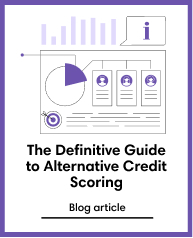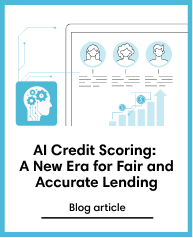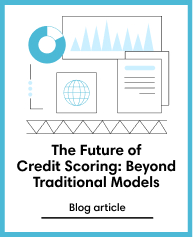Credit Scoring
Jul 15, 2020
Credit Scores 101: The Key Powering Your Financial Independence
Subscribe to our newsletter
Credit scores are fundamental in a lender’s decision to provide credit. In this article, we will review how a traditional credit risk analysis is performed and how it has evolved with time and technology.
What is a credit score?
A credit score is a number generally ranging from 300-850 that depicts the borrower’s creditworthiness or default risk for a lender. Banks and lenders use it as a credit risk indicator in order to decide whether they’ll approve the borrower for a credit card or loan. Financial institutions usually judge people with higher credit scores to have lower credit risk and thus grant them a broader selection of credit products at lower interest rates. Basically, the higher the borrower’s credit score, the more attractive this person is to lenders.
Major credit bureaus are responsible for doing credit analysis and building consumer credit reports in each country. These reports are then provided to financial institutions, such as mortgage lenders, credit card companies and others who decide whether or not to extend credit to the borrower. The credit report information included in one report might be slightly different from that in another.
However, generally, credit scores range as follows:

How is a credit score calculated?
If the borrower has any credit accounts, such as credit cards or loans, then he/she also has a credit report. The borrower’s credit report is a record of how that person manages money. This data is then distilled and calculated to create a credit score by credit bureaus.
While there can be differences in the information collected by credit bureaus, there are five main factors evaluated when calculating risk score: payment history, debt level, credit length, types of credit (credit cards, auto loans, student loans, mortgages, etc.), credit limits and how much of those limits are being used, and new credit accounts.
To see how it all breaks down, here's an example of how credit risk is calculated. The borrower’s payment history generally makes up 40% of the score, while credit utilisation is 20%. The length of the credit history contributes 21%, and the total amount of recently reported balances 11%. Finally, new credit accounts are responsible for 5% while the available credit makes up 3%.
Evaluating the borrower’s credit risk: Traditional and alternative scoring
It can be confusing when the borrower's credit bureau score seems high but the person is still denied for a new line of credit. Chances are this is not the same score as the one available by the bank or finance company as financial institutions have a more complex process of evaluating applications which includes the credit bureau scores as well as their own internal checks.
Traditional credit scores may vary according to the scoring model used, and different lenders may have different criteria when it comes to granting credit. Also, the types of credit risk indicators used by lenders and creditors may also vary based on their industry. For example, if a person is buying a car, an auto lender might use a credit score that places more emphasis on the payment history when it comes to auto loans, rather than, say, the amount of credit the person owes. Also, in the absence of or in addition to credit bureau data, lenders might look into alternative sources of creditworthiness such as his/her bank account data, utility bills paid, rent data, social media activity, psychometrics, telco data and smartphone metadata.
At credolab for example, we collect alternative data from smartphone devices in a privacy-consented way, while customers apply for a BNPL product, any cash loan or a credit card. The CredoSDK product adds digital behavioural insights to the underwriting mix and lets businesses accurately identify customers who meet the risk standards.
The bottom line is, a credit score can cost or save a lot of money in a person’s lifetime. Thankfully, any risk assessment can now be improved with a combination of both traditional and alternative scoring methods. Artificial intelligence and machine learning have made it possible for lenders to automate their processes and adopt fintech credit scoring methods to better serve customers.
Want to know more about credit scores? Read on to understand what are the key 3 steps in any credit analysis.






